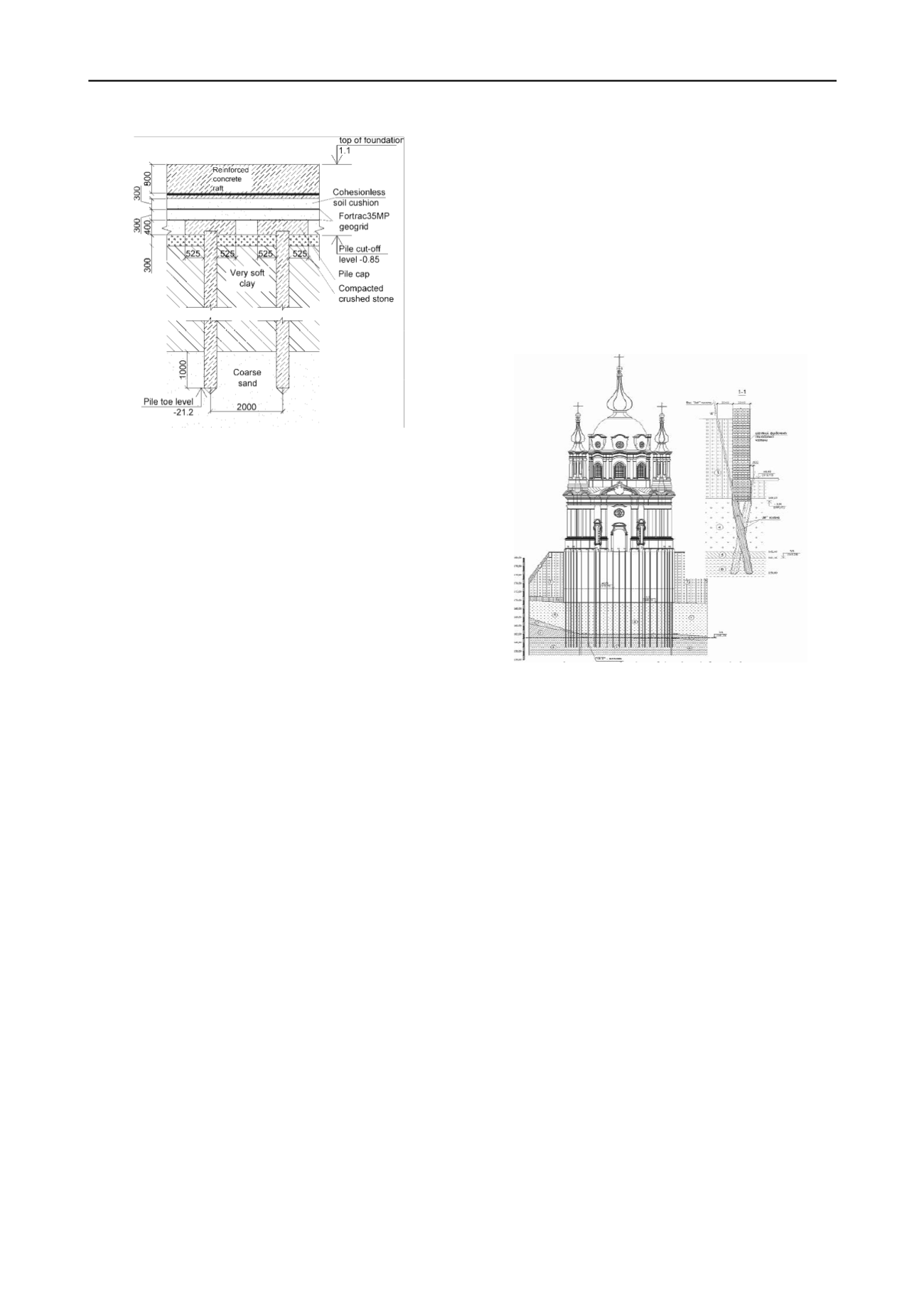
3093
Technical Committee 301 /
Comité technique 301
Figure 13. Foundation of the Organizing committee Building in Sochi
(Russia). Detail of the pile foundation disconnected from the raft
(
Petrukin et al. 2013
).
layer between piles and raft has started in seismic areas of the
USSR in the 1960s, and this is very interesting as only few, and
more recent, experiences (e.g. Thornburn
et al.
1983,
Jamiolkowski
et al.
2009) are described in literature.
The critical geological conditions of the territory of Ukraine are
described by
Slyusarenko et al. (2013)
, which are of concern as
about 60% of the territory is interested by formations of
collapsible soils or unstable slopes. Considering the
geotechnical problems posed by such soils, the authors describe
two case histories: one pertaining to an underground parking lot
realized with a top-down procedure, the other referring to the
reparation works carried out to preserve a valuable 18
th
century
baroque church. As far as the latter is concerned, a number of
static problems affected the structure in time, with leaning parts
and diffused crack patterns. The church is positioned on top of a
hill, which was found to be not far from limit equilibrium
conditions.
Slyusarenko et al. (2013)
shortly report the list of
investigations and of the numerical analyses carried out. They
also describe in some detail the adopted solutions, even though
no details on soil properties, slope geometry and stability
analyses are given in the paper. Along with extensive
restoration of the superstructure, it was finally decided to
underpin the church with jet grouting (Figure 14). As previously
discussed (see §2.1), this is a rather invasive intervention which
irreversibly compromises
authenticity
of the monument. Even
though underpinning cannot be excluded a priori, it should be
carried out only if no alternatives are available which would
induce similar beneficial static effects. Since slides were
observed along the slope, and slope stability safety margins
were extremely reduced, it would have been interesting to know
if slope superficial and deep displacements were monitored, for
instance with inclinometers. In fact, such displacements may
have caused at least part of the static problems experienced by
the church, as shown in this session by
Valore and Ziccarelli
(2013)
with reference to the similar case of a church placed on
top of a hill with a slope close to failure.
In any case,
Slyusarenko et al (2013)
have used jet grouting
to underpin the church instead of more traditional techniques, as
for instance micropiles. This choice may be convenient, because
large columns can be formed drilling small holes into the soil by
correctly tuning the treatment energy (Flora
et al.
2013).
However, extreme caution should be adopted when using jet
grouting close to very sensitive buildings (Croce
et al.
2013).
Furthermore, it is well known that the highly energetic grout jet
may cause undesired settlements when used in unsaturated
collapsible soils as the upper ones seem to be under the church.
In any case, the authors report that the underpinning works were
successful, as the displacements have stopped.
Referring to similarly problematic soils,
Usmanov et al.
(2013)
summarise the typical foundation systems in the very
critical geotechnical conditions encountered in most of the
territory of the Republic of Tajikistan. Even though the
described systems are traditional, the site conditions in which
they are applied are sometimes extreme, being the area highly
seismic, with largely spread thick layers of unsaturated
collapsible loess and weak saturated soils. The authors report
that even in such critical conditions, the foundation solution
reported in the paper have proven to be successful for medium
rise buildings (up to 12 storeys).
Figure 14. Underpinning with jet grouting columns of St. Andrew
Church in Kyiv (Ukraine) (
Slyusarenko et al. 2013
).
Recently, a number of large projects has started in the new born
state of Kazakhstan, and in its capital Astana in particular. The
town is located in the Kazakh steppe, and the subsoil is
constituted of erratic layers of soft and hard soils; in the most
superficial part, soil freezes during the extremely severe winter.
Because of these complex geotechnical conditions, deep
foundations are usually adopted, and new technologies in pile
construction and testing considered too.
Zhussupbekov et al.
(2013)
, for instance, in their paper summarize some experiences
relative to continuous flight auger piles (CFA piles, usually
classified as replacement piles, even though the soil is partially
displaced during installation) and displacement screw piles (in
the paper named DDS piles). They show an interesting
comparison between static and dynamic loading tests: in the
cases reported in the paper, the dynamic tests largely
underestimate the ultimate axial load of the piles, being also
very sensitive to the kind of hammer adopted in testing. The
authors also discuss the use of alternative testing procedures
which may be more convenient, as the Osterberg Cell tests
(Russo, 2013). Even though the paper contains interesting
experimental data, it is very difficult to get an insight on them
as information are given neither on the properties of the soils in
which the test piles were realized, nor on the piles themselves.
4 CONCLUSIONS
The session deals with a number of complexities, related to the
structures to preserve (monuments and historic sites), to the
soils to characterize or to the design constraints posed for new
structures by difficult regional conditions in highly seismic


